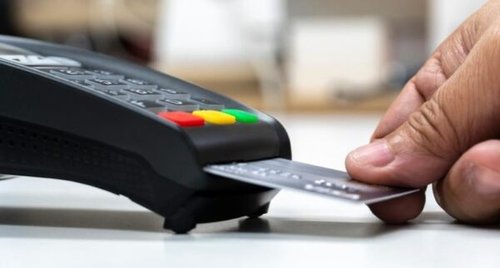Steve Jobs became a global icon for his contributions to computers, phones and music. While the signs are clear, we don’t always acknowledge it — Steve Jobs also managed to completely transform the credit card payments industry, and the proof is in the pudding.
Steve Jobs changed how we handle money
Jobs didn’t invent mobile banking but let’s not forget it was the original iPhone that made mobile platforms for financial institutions common place. The original iPhone is what made us all realize cellphones weren’t just a platform for playing snake; they were a camera, a GPS, a jukebox and an opportunity for developers to create apps for almost anything you can think of. Remember the old marketing campaign “there’s an app for that!”
Almost immediately after the original iPhone announcement, we saw apps spring up that helped people spend money, save money, monitor money, and invest money. Everything from the ability to snap a photo of a paycheck and make a deposit to your checking account to swiping our phones at the grocery store checkout to pay. All of these apps directly affected the financial vertical.
The Federal Reserve recently conducted a study observing the adoption rate for mobile banking from 2011 to present. Adoption has grown year-over-year: In 2011 only 45 percent of 18-29 year olds adopted mobile banking, and in 2014 60 percent now utilize mobile banking. In 2011 the 60+ age category marked the smallest adoption rate of any age group with only 5 percent welcoming mobile banking; in 2014 13 percent of 60+ have adopted mobile banking.
The progression of mobile banking has started to make physical banking and credit cards themselves obsolete – and Apple Pay has only perpetuated this movement. Jobs’ predecessor Tim Cook, announced Apple Pay in 2014. The concept allows consumers to store “dummy” credit cards numbers to our phone’s “secure element” and keeps our actual credit card numbers are linked directly to our credit card company’s secure network. We can now tap our phones on technology held by most major retailer’s making physical cards unnecessary. As adoption rates for mobile banking continue to grow, and Apply Pay continues to gain popularity, could this be a precursor for the credit card industry to move toward non-plastic mobile payments altogether?
Steve Jobs changed information accessibility
Jobs can be accredited for making technology friendly and accessible – a seemingly innocent accolade. However, part of the evolution of technology also created a culture for increased information insecurities — with increased accessibility to consumer data, security breaches financial institutions weren’t equipped to handle followed.
When Jobs debuted the iPod in 2001, millions of us, no doubt, ditched our CDs and DVDs and signed up for that new-aged marketplace, the ITunes store. In 2013 Jobs spoke to an audience in San Francisco, and said that iTunes had 200 million accounts tied to credit cards which at that time, jobs said might very well be “the largest database of customer accounts in the world.”
Now flash forward to September of 2015, when Apple announced that hackers have stolen more than 225,000 Apple accounts from iPhone customers. This certainly isn’t the first hack to make headlines, but reiterates the vulnerability consumers feel when it comes to online information –especially financial information.
The aforementioned Federal Reserve study, which garnered 945 respondents, saw a response rate of 62 percent concerned about the security of mobile banking. The security concerns are widespread:
- Fears of someone intercepting data
- Fears of phones getting hacked
- Fears of someone using a phone without permission to access accounts
- Fears of companies misusing personal information
- Fears of Malware or viruses getting placed on phones
- Fears of losing phone with sensitive information on it
In order to curb mistrust, and instill security measures, credit card companies were recently mandated to issue EMV credit cards by October 2015. EMV chips are credit cards with computer-encoded security. The technology was created as a way to counter data breaches and fraud, and help reduce overall costs of hacks. But has Apple already surpassed the credit card industry with security?
Apple has stated that Apple Pay is effectively the same two-step chip-and-PIN credit card system. According to Apple, the Device Account Number is assigned, encrypted, and securely stored in the Secure Element, a dedicated chip in iPhone and Apple Watch, and when a payment is initiated, the token is passed to the retailer or merchant. This means that retailers never actually have direct access to your card information – making breaches less likely.
While Apple has certainly tried to take down the credit card industry, they haven’t succeeded. With every innovation of technology the credit card industry continues to get stronger, and more collaborative. We foresee major milestones in the credit card industry soon, in part because of the enormous strides Jobs and Apple have taken.


